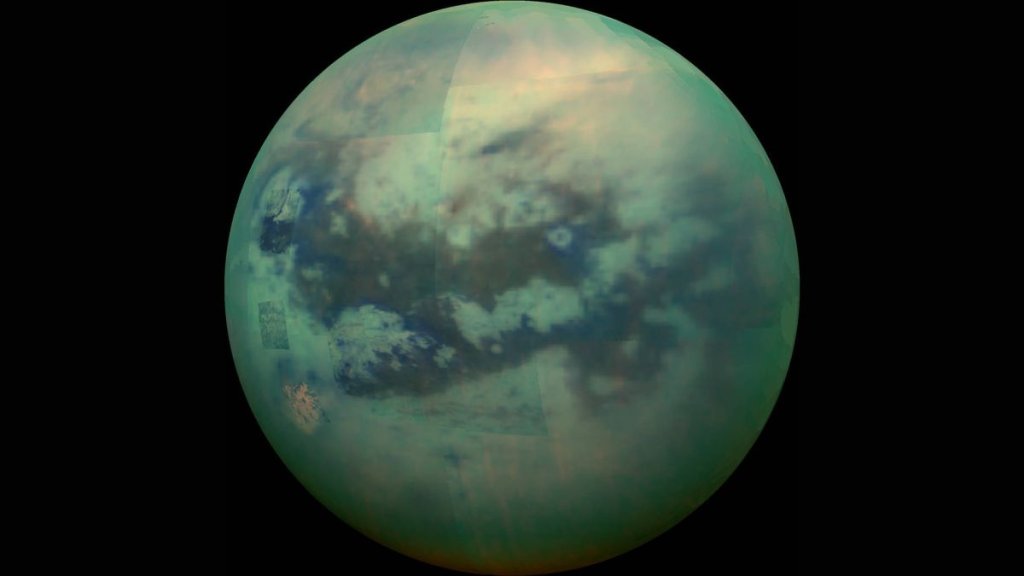
Strange winds blow on Saturn’s moon Titan. New clues could solve this decades-old mystery (Image Credit: Space.com)
New research is shedding light on peculiar winds swirling on Saturn’s largest moon, Titan, whose mysterious weather patterns have puzzled astronomers for decades.
The answers may help to explain how Titan became the only moon in the solar system that still hosts a planet-like atmosphere, researchers say.
Astronomers have long known that seasons on Titan — each of which lasts nearly 7.5 Earth years — affect the moon’s winds. But they haven’t been able to pin down the speeds of those winds; two related studies, done nearly 30 years apart, have led to contradictory findings.
Now, astronomers are revisiting this decades-old mystery with updated telescopes. The paradoxical findings from past research might have resulted from incorrect assumptions about the data or instrument limitations, or it may just be that “there’s something basic that we don’t understand,” Eliot Young, a principal scientist at the Southwest Research Institute in Texas, said in a statement (opens in new tab).
Related: Titan: Facts about Saturn’s largest moon
Titan has a thick, smog-like atmosphere that reaches 370 miles (600 kilometers) into space and is 95% nitrogen with a sprinkle of organic molecules. Winds on the moon encircle it in just a day, repeatedly carrying currents of warm air from lower altitudes to the moon’s poles, as if blowing on what NASA calls a high-speed conveyor belt.
In 1989, astronomers found that Titan’s winds are slowest near its equator and fastest at midlatitudes in both the northern and southern hemispheres. This was revealed thanks to a chance alignment of a star behind Titan that allowed astronomers to study how the star’s dimming light filtered through the moon’s atmosphere, which helped them interpret wind speeds.
In 2016, a different team used ground-based telescopes to study how the light beamed by molecules in the atmosphere changed with shifting wind speeds and directions. The findings from this method revealed the opposite: The winds were fastest near Titan’s equator and slowest at its lower latitudes.
Because there’s a nearly three-decade gap between the two sets of observations, astronomers think different seasons on Titan may have led to the dramatic wind changes between both studies. Also, the 1989 research studied winds circling in the middle layers of the moon’s atmosphere, while the more recent research focused on winds in the upper layers, which also may explain the varying wind speeds, the astronomers said.
“Just like on Earth, the winds on Titan are different at different altitudes and also change with seasons,” Juan Lora, an assistant professor of Earth and planetary sciences at Yale University, told Space.com in an email. “And both of these likely explain why the observations don’t agree perfectly with each other.”
To get to the bottom of this discrepancy, a group of scientists has collected new data about Titan’s winds using both methods at the same time. Last year, the team used eight telescopes in the United States and South America to observe two chance alignments of Earth, Titan and faraway bright stars.
In September 2022, four telescopes in Hawaii — including NASA’s Infrared Telescope Facility and the Keck Observatory — watched as the star, 2MASS 21312124-1602427, snuck behind Titan. In November of the same year, a different star called 2MASS 21292356-1611056 slid behind Titan. Data from this event was collected by four more telescopes in Chile, including the Very Large Telescope and the Atacama Large Millimeter/submillimeter Array (ALMA).

The team is still comparing data from both observations and expects the results to be ready later this year. So far, ALMA observations already show evidence of speedy winds parallel to Titan’s equator, Martin Cordiner, a planetary science researcher at NASA’s Goddard Space Flight Center in Maryland whose team first identified the discrepancy in 2021, told Space.com.
The researchers behind the latest study said they were just in time to capture valuable data about Titan’s winds before the 2025 northern autumnal equinox, when both of the moon’s hemispheres will briefly receive equal sunlight before its northern hemisphere points more directly toward the sun. During this time, Titan’s winds will reverse directions and start flowing from north to south — a change that has sprouted powerful dust storms (opens in new tab) in the past, according to the journal Nature.
“Titan is amazingly similar to Earth in many ways, but it’s also alien and often surprising — teasing out which of these applies to individual phenomena as we observe them is one of the fun bits about this research for me,” Lora told Space.com.





